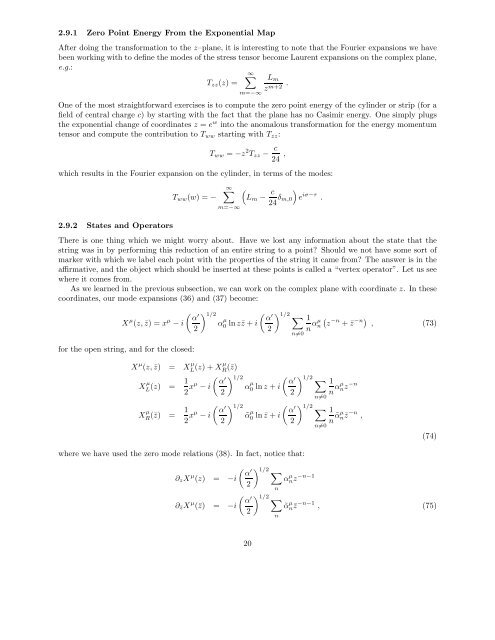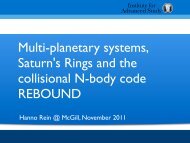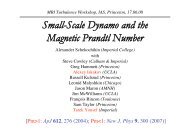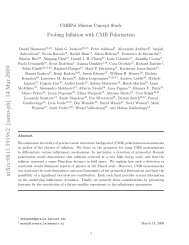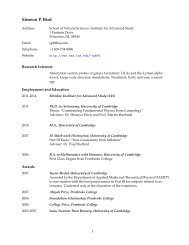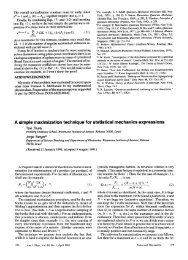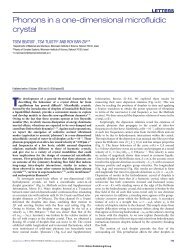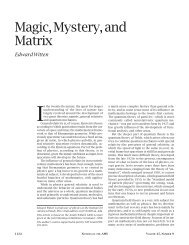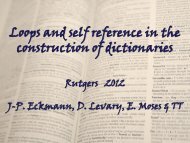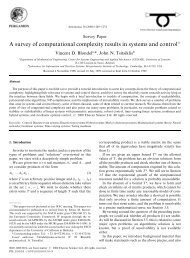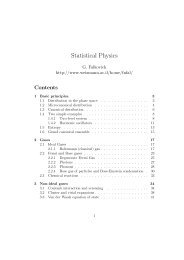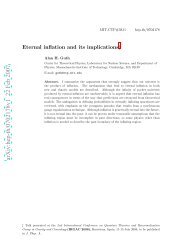Introduction to String Theory and D–Branes - School of Natural ...
Introduction to String Theory and D–Branes - School of Natural ...
Introduction to String Theory and D–Branes - School of Natural ...
You also want an ePaper? Increase the reach of your titles
YUMPU automatically turns print PDFs into web optimized ePapers that Google loves.
2.9.1 Zero Point Energy From the Exponential Map<br />
After doing the transformation <strong>to</strong> the z–plane, it is interesting <strong>to</strong> note that the Fourier expansions we have<br />
been working with <strong>to</strong> define the modes <strong>of</strong> the stress tensor become Laurent expansions on the complex plane,<br />
e.g.:<br />
Tzz(z) =<br />
∞<br />
m=−∞<br />
Lm<br />
.<br />
zm+2 One <strong>of</strong> the most straightforward exercises is <strong>to</strong> compute the zero point energy <strong>of</strong> the cylinder or strip (for a<br />
field <strong>of</strong> central charge c) by starting with the fact that the plane has no Casimir energy. One simply plugs<br />
the exponential change <strong>of</strong> coordinates z = e w in<strong>to</strong> the anomalous transformation for the energy momentum<br />
tensor <strong>and</strong> compute the contribution <strong>to</strong> Tww starting with Tzz:<br />
Tww = −z 2 Tzz − c<br />
24 ,<br />
which results in the Fourier expansion on the cylinder, in terms <strong>of</strong> the modes:<br />
2.9.2 States <strong>and</strong> Opera<strong>to</strong>rs<br />
Tww(w) = −<br />
∞<br />
m=−∞<br />
<br />
Lm − c<br />
24 δm,0<br />
<br />
e iσ−τ .<br />
There is one thing which we might worry about. Have we lost any information about the state that the<br />
string was in by performing this reduction <strong>of</strong> an entire string <strong>to</strong> a point? Should we not have some sort <strong>of</strong><br />
marker with which we label each point with the properties <strong>of</strong> the string it came from? The answer is in the<br />
affirmative, <strong>and</strong> the object which should be inserted at these points is called a “vertex opera<strong>to</strong>r”. Let us see<br />
where it comes from.<br />
As we learned in the previous subsection, we can work on the complex plane with coordinate z. In these<br />
coordinates, our mode expansions (36) <strong>and</strong> (37) become:<br />
X µ (z, ¯z) = x µ − i<br />
α ′<br />
for the open string, <strong>and</strong> for the closed:<br />
X µ (z, ¯z) = X µ<br />
L<br />
2<br />
1/2<br />
X µ 1<br />
L (z) =<br />
2 xµ − i<br />
X µ 1<br />
R (¯z) =<br />
2 xµ − i<br />
α µ<br />
0 lnz¯z + i<br />
(z) + Xµ<br />
R (¯z)<br />
′ α<br />
2<br />
α ′<br />
2<br />
1/2<br />
1/2<br />
′ 1/2<br />
α 1<br />
2 n αµ −n −n<br />
n z + ¯z , (73)<br />
α µ<br />
0 lnz + i<br />
˜α µ<br />
0 ln ¯z + i<br />
where we have used the zero mode relations (38). In fact, notice that:<br />
n=0<br />
∂zX µ ′ 1/2<br />
α <br />
(z) = −i α<br />
2<br />
n<br />
µ nz −n−1<br />
∂¯zX µ ′ 1/2<br />
α <br />
(¯z) = −i<br />
2<br />
20<br />
n<br />
′ 1/2<br />
α 1<br />
2 n αµ nz −n<br />
n=0<br />
′ 1/2<br />
α 1<br />
2 n ˜αµ n¯z −n ,<br />
n=0<br />
(74)<br />
˜α µ n ¯z−n−1 , (75)


